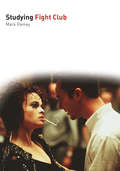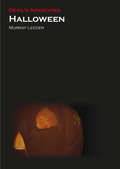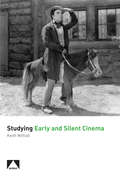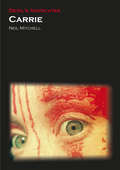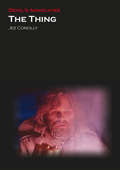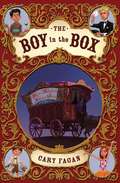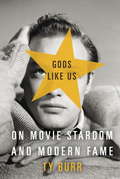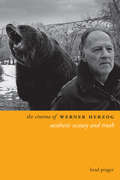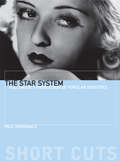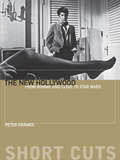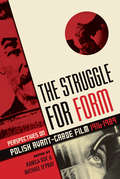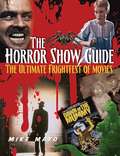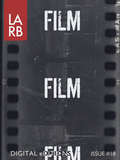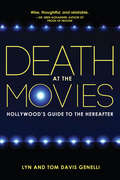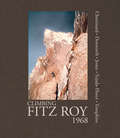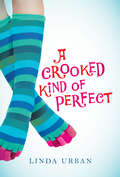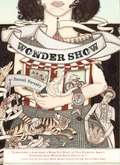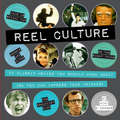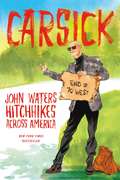- Table View
- List View
Studying Fight Club
by Mark RameyA thoughtful and provocative but also accessible analysis of a pop-culture phenomenon and a deeply philosophical and satirical exploration of modern life.
Devil's Advocates: Halloween
by Murray LeederA bold and provocative study of Carpenter's film, which hopes to expose qualities that are sometime effaced by its sequels and remakes
Studying Early and Silent Cinema
by Keith WithallA comprehensive chronology of the period until the birth of sound and also a series of detailed case studies on the key films from the period
Carrie
by Neil MitchellNot only breaks the film down into its themes, stylistic tropes, technical approaches, uses of color and sound, dialogue, and visual symbolism but also considers a multitude of other factors contributing to the work's classic status
The Thing
by Jez ConollyConolly looks back to the film's antecedents and to the changing nature of its reception and the work that it has influenced
The Boy in the Box
by Cary Fagan"If you always feel fully and completely happy, my friends, then you do not need my drops and I will not sell them to you for any amount of money." --Master Melville Eleven-year-old juggling enthusiast Sullivan Mintz helps his family run the Stardust Home for Old People. It's not ideal: his best friend, Manny, is eighty-one years old. But life as usual turns upside down when Master Melville's Medicine Show comes to town. Sullivan's excitement at finding performers his own age dissolves into dread when he steps onstage for a magic act only to wake up imprisoned in the traveling show's caravan. As his fears subside, his questions multiply. Is his family better off without him? Would life as a juggler performing with other kids be worse than living in an old folks' home? Being kidnapped could be the best thing that ever happened to him . . . or decidedly not.
Gods Like Us
by Ty BurrWITH 8 PAGES OF BLACK-AND-WHITE PHOTOGRAPHSHow--and why--do we obsess over movie stars? How does fame both reflect and mask the person behind it? How have the image of stardom and our stars' images altered over a century of cultural and technological change? Do we create celebrities, or do they create us? Ty Burr, film critic for The Boston Globe, answers these questions in this lively and fascinating anecdotal history of stardom, with all its blessings and curses for star and stargazer alike. From Mary Pickford and Charlie Chaplin to Archie Leach (a.k.a. Cary Grant) and Marion Morrison (a.k.a. John Wayne), Tom Cruise and Julia Roberts, and such no-cal stars of today as the Kardashians and the new online celebrity (i.e., you and me), Burr takes us on an insightful and entertaining journey through the modern fame game at its flashiest, most indulgent, occasionally most tragic, and ultimately, its most revealing.ine celebrity (i.e., you and me), Burr takes us on a brilliantly insightful and entertaining journey through the modern fame game at its flashiest, its most indulgent, occasionally its most tragic and, ultimately, its most culturally revealing.From the Hardcover edition.
The Cambridge Introduction to Comedy
by Eric Weitz'Laughter', says Eric Weitz, 'may be considered one of the most extravagant physical effects one person can have on another without touching them'. But how do we identify something which is meant to be comic, what defines something as 'comedy', and what does this mean for the way we enter the world of a comic text? Addressing these issues, and many more, this is a 'how to' guide to reading comedy from the pages of a dramatic text, with relevance to anything from novels and newspaper columns to billboards and emails. The book enables you to enhance your grasp of the comic through familiarity with characteristic structures and patterns, referring to comedy in literature, film and television throughout. Perfect for drama and literature students, this Introduction explores a genre which affects the everyday lives of us all, and will therefore also capture the interest of anyone who loves to laugh.
The Cinema of Werner Herzog
by Kirsten Moana ThompsonWerner Herzog is renowned for pushing the boundaries of conventional cinema, especially those between the fictional and the factual, the fantastic and the real. The Cinema of Werner Herzog: Aesthetic Ecstasy and Truth is the first study in twenty years devoted entirely to an analysis of Herzog's work. It explores the director's continuing search for what he has described as 'ecstatic truth,' drawing on over thirty-five films, from the epics Aguirre: Wrath of God (1972) and Fitzcarraldo (1982) to innovative documentaries like Fata Morgana (1971), Lessons of Darkness (1992), and Grizzly Man (2005). Special attention is paid to Herzog's signature style of cinematic composition, his "romantic" influences, and his fascination with madmen, colonialism, and war.
The New Hollywood
by Peter KramerOn December 8, 1967 Time magazine put Bonnie and Clyde on its cover and announced, "The New Cinema: Violence ... Sex ... Art." The following decade has long been celebrated as a golden age in American film history. In this innovative study, Peter Krämer offers a systematic discussion of the biggest hits of the period (including The Graduate [1967], The Exorcist [1973] and Jaws [1975]). He relates the distinctive features of these hits to changes in the film industry, in its audiences and in American society at large.
The Struggle for Form
by Kamila KucThis is the first comprehensive English-language account of the Polish avant-garde film, from its beginnings in the early decades of the last century to the collapse of communism in 1989. Taking a broad understanding of avant-garde film, this collection includes writings on the pioneering work of the internationally-acclaimed Franciszka and Stefan Themerson; the Polish Futurists' (Jalu Kurek, Anatol Stern) engagement with film; the Thaw and animation (Jan Lenica and Walerian Borowczyk, Andrzej Pawlowski, Zbigniew Rybczynski); documentary (Natalia Brzozowska, Kazimierz Karabasz, Wojciech Wiszniewski), Polish émigré filmmakers (Roman Polanski, Jerzy Skolimowski, Andrzej Zulawski) as well as essays and documentation on the highly influential Film Form Workshop (Józef Robakowski, Ryszard Wasko, Wojciech Bruszewski). Including a mix of historical writings from early film magazines with commissioned essays, this book constitutes an important source on the rich, complex and diverse history of the Polish film avant-garde, which is presented from the perspective of both British (A. L. Rees, Jonathan Owen, Michael O'Pray) and Polish (Marcin Gizycki, Ryszard Kluszczynski, Kamila Kuc) authorities on the subject. This book is thus an indispensable introduction to the theories and practices of critically important avant-garde artists and filmmakers.
The Cinema of Werner Herzog
by Kirsten Moana ThompsonWerner Herzog is renowned for pushing the boundaries of conventional cinema, especially those between the fictional and the factual, the fantastic and the real. The Cinema of Werner Herzog: Aesthetic Ecstasy and Truth is the first study in twenty years devoted entirely to an analysis of Herzog's work. It explores the director's continuing search for what he has described as 'ecstatic truth,' drawing on over thirty-five films, from the epics Aguirre: Wrath of God (1972) and Fitzcarraldo (1982) to innovative documentaries like Fata Morgana (1971), Lessons of Darkness (1992), and Grizzly Man (2005). Special attention is paid to Herzog's signature style of cinematic composition, his "romantic" influences, and his fascination with madmen, colonialism, and war.
The Horror Show Guide
by Mike MayoFrom atomic bombs to zealous zombies, this cinefile's guidebook reviews 1,000 of the wickedest, weirdest, and wackiest scary movies from every age of horror. With reviews on many overlooked, underappreciated gems such as Alice Sweet Alice, Daughters of Darkness, and Zombie, as well as the numerous Stephen King adaptations and modern updates such as Night of the Living Dead 3D and The Wolfman, new devotees as well as the discriminating darkcinema enthusiast will love this big, beautiful, endall, beall guide to an always popular film genre. Established directors, including Wes Craven, John Carpenter, Tim Burton, David Cronenberg, and Guillermo del Toro are given their due, as are the new generation, represented by Larry Fessenden, James Wan, Alexandre Aja, and others. In addition to the hundreds of horror film reviews, this guide includes fascinating and fun top10 lists and sidebars that are designed to lead fans to similar titles they might not have known about.
LARB Digital Edition: Film and the Art of Adaptation
by Merve EmreMore so than any other art form, film relies on collaboration. The essays in this collection, "Film and the Art of Adaptation," consider a range of contemporary films inspired by celebrated works of American literature, including Baz Luhrmann's spectacular take on The Great Gatsby and James Franco's faithful transposition of As I Lay Dying.Ruth Yeazell considers the difficulty of representing the interior life of one of Henry James's orphaned children in "Updating What Maisie Knew," while Len Gutkin's sassy pan, "A Beatnik Animal House," shows how John Krokidas's adolescent romp Kill Your Darlings butchers the murder that launched the Beat movement. Lowry Pressly's discussion of Steve McQueen's humane and heartbreaking 12 Years A Slave defends McQueen from charges of sadism in his adaptation of Solomon Northup's little-read slave narrative. Rounding out the collection is Jerry Christensen's take down of historian Ben Urwand's controversial book The Collaboration: Hollywood's Pact with Hitler.From adaptation to collaboration, these six essays illuminate how writers, directors, and actors work together across yawning gaps in time and space to bring history and literature to the silver screen.
The New Hollywood
by Peter KramerOn December 8, 1967 Time magazine put Bonnie and Clyde on its cover and announced, "The New Cinema: Violence ... Sex ... Art." The following decade has long been celebrated as a golden age in American film history. In this innovative study, Peter Krämer offers a systematic discussion of the biggest hits of the period (including The Graduate [1967], The Exorcist [1973] and Jaws [1975]). He relates the distinctive features of these hits to changes in the film industry, in its audiences and in American society at large.
The Struggle for Form
by Kamila KucThis is the first comprehensive English-language account of the Polish avant-garde film, from its beginnings in the early decades of the last century to the collapse of communism in 1989. Taking a broad understanding of avant-garde film, this collection includes writings on the pioneering work of the internationally-acclaimed Franciszka and Stefan Themerson; the Polish Futurists' (Jalu Kurek, Anatol Stern) engagement with film; the Thaw and animation (Jan Lenica and Walerian Borowczyk, Andrzej Pawlowski, Zbigniew Rybczynski); documentary (Natalia Brzozowska, Kazimierz Karabasz, Wojciech Wiszniewski), Polish émigré filmmakers (Roman Polanski, Jerzy Skolimowski, Andrzej Zulawski) as well as essays and documentation on the highly influential Film Form Workshop (Józef Robakowski, Ryszard Wasko, Wojciech Bruszewski). Including a mix of historical writings from early film magazines with commissioned essays, this book constitutes an important source on the rich, complex and diverse history of the Polish film avant-garde, which is presented from the perspective of both British (A. L. Rees, Jonathan Owen, Michael O'Pray) and Polish (Marcin Gizycki, Ryszard Kluszczynski, Kamila Kuc) authorities on the subject. This book is thus an indispensable introduction to the theories and practices of critically important avant-garde artists and filmmakers.
Death at the Movies
by Tom And GenelliIt's a Wonderful Life (1946), Resurrection (1980), Poltergeist (1982), Beetlejuice (1988), Ghost (1990), Groundhog Day (1993), The Sixth Sense (1999) - these are only a few of the influential movies in recent decades dealing with the afterlife. But beyond entertainment, do they mean anything? The authors of this wise and well-informed guide believe so. They explore how popular motion pictures, from Outward Bound (1930) to Hereafter, play a perhaps unconscious role in guiding humanity toward its evolutionary comprehension of the meaning and purpose of death. They draw on the Tibetan Book of the Dead, Buddhism, and depth psychology to review some of the most spiritually powerful films ever made. Death is, say the authors, at once the most immediate locked door and the ultimate frontier, a staggering paradox that invites us to search for deeper understanding based upon a level of consciousness beyond thought. After reading this book, you'll never view Casablanca or The Wizard of Oz the same way again.
Climbing Fitz Roy, 1968
by Lito Tejada-Flores Chris Jones Yvon Chouinard Doug Tompkins Dick DorworthThis book features rare, once-thought-lost photos of the 1968 first ascent of the California Route on Cerro Fitz Roy, the third ascent of the mountain. With accompanying retrospective essays. Climbing Fitz Roy,1968, presents photo documentation of the climb, places it in the social and climbing context of the times, and reflects how this momentous trip influenced the lives of those involved, and in a greater context, the lives of so many others.
A Crooked Kind of Perfect
by Linda UrbanTen-year-old Zoe Elias has perfect piano dreams. She can practically feel the keys under her flying fingers; she can hear the audience's applause. All she needs is a baby grand so she can start her lessons, and then she'll be well on her way to Carnegie Hall. But when Dad ventures to the music store and ends up with a wheezy organ instead of a piano, Zoe's dreams hit a sour note. Learning the organ versions of old TV theme songs just isn't the same as mastering Beethoven on the piano. And the organ isn't the only part of Zoe's life that's off-kilter, what with Mom constantly at work, Dad afraid to leave the house, and that odd boy, Wheeler Diggs, following her home from school every day. Yet when Zoe enters the annual Perform-O-Rama organ competition, she finds that life is full of surprises--and that perfection may be even better when it's just a little off center.
Wonder Show
by Hannah BarnabyLadies and gentlemen, boys and girls, step inside Mosco's Traveling Wonder Show, amenagerie of human curiosities and misfits guaranteed to astound and amaze!But perhaps the strangest act of Mosco's display is Portia Remini, a normal amongthe freaks, on the run from McGreavy's Home for Wayward Girls, where Misterwatches and waits. He said he would always find Portia, that she could never leave.Free at last, Portia begins a new life on the bally, seeking answers about her father'sdisappearance. Will she find him before Mister finds her? It's a story for the ages, andlike everyone who enters the Wonder Show, Portia will never be the same.
Scandalous!
by Hallie FrydDo you love a good scandal? This book includes 50 juicy pop culture, political, and entertainment-related scandals complete with photos, event synopses, and a look at why it went down in history and how it continues to influence us today. Other features include famous quotes and a section on where the players are now. Teens will get the dish on: Milli Vanilli's lip-syncing the Clinton-Lewinsky affair the Biggie and Tupac murders the Kent State shooting the OJ Simpson Murder trial Patty Hearst's kidnapping And more!
Reel Culture
by Mimi O'ConnorTeens love movies. But when we start talking about the movies from last century, they're often in the dark. Reel Culture is for the young person who is curious about film history, and wants to be the one at the party who knows what Casablanca was about or who first made the LBD (little black dress) hot in Breakfast at Tiffany's. From Willy Wonka and the Chocolate Factory to Raiders of the Lost Ark, Reel Culture explores the 50 most influential--yet often unknown to teens--films of the 20th century.
Carsick: John Waters Hitchhikes Across America
by John WatersA cross-country hitchhiking journey with America’s most beloved weirdo John Waters is putting his life on the line. Armed with wit, a pencil-thin mustache, and a cardboard sign that reads “I’m Not Psycho,” he hitchhikes across America from Baltimore to San Francisco, braving lonely roads and treacherous drivers. But who should we be more worried about, the delicate film director with genteel manners or the unsuspecting travelers transporting the Pope of Trash? Before he leaves for this bizarre adventure, Waters fantasizes about the best and worst possible scenarios: a friendly drug dealer hands over piles of cash to finance films with no questions asked, a demolition-derby driver makes a filthy sexual request in the middle of a race, a gun-toting drunk terrorizes and holds him hostage, and a Kansas vice squad entraps and throws him in jail. So what really happens when this cult legend sticks out his thumb and faces the open road? His real-life rides include a gentle eighty-one-year-old farmer who is convinced Waters is a hobo, an indie band on tour, and the perverse filmmaker’s unexpected hero: a young, sandy-haired Republican in a Corvette. Laced with subversive humor and warm intelligence, Carsick is an unforgettable vacation with a wickedly funny companion—and a celebration of America’s weird, astonishing, and generous citizenry.
